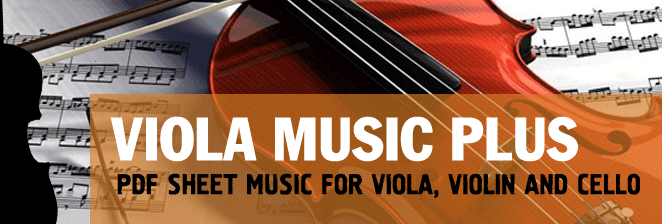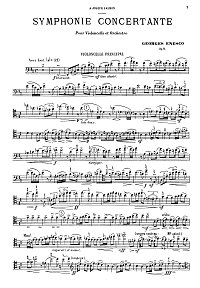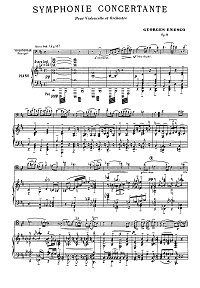|
|
 |
|
| |
| |
Enescu - Symphony - Concertante for cello and orchestra op.8
Enescu - Symphony - Concertante for cello and orchestra op.8. You can download the PDF sheet music Enescu - Symphony - Concertante for cello and orchestra op.8 on this page. The Symphonie concertante is one of a series of astonishingly assured compositions produced by George Enescu in his later teens. The Symphonie concertante, completed on 2 November 1901 is in two expansive sonata-movements linked in one huge span; the first marked Assez lent ('Quite slow'), with an intervening section, Un peu plus animé, and the second Majestueux. As well as being one of the world's foremost violinists, a magnificent pianist and, later, a conductor good enough to have been considered as Toscanini's successor in New York, Enescu was also a fine cellist, and the solo writing in the Symphonie concertante reveals his complete understanding of the instrument.
Enescu did think of calling the work a cello concerto (the manuscript solo part bears that designation) but, perhaps recognizing that he had written something very different from the standard showpiece, chose its present title instead - a gift to the critics at its poorly received first performance, when it was labelled a Symphonie déconcertante. With a century of hindsight -during which, inexplicably, cellists have generally ignored it - we can see it as an innovative, and moving, masterpiece.
To download PDF, click the "Download PDF" button below the appropriate sheet music image.
To view the first page of Enescu - Symphony - Concertante for cello and orchestra op.8 click the music sheet image. |
| PDF format sheet music |
|
|
|
Instrument part: 8 pages. 775 K
|
Piano part: 32 pages. 2417 K
|
 |
 |
|
|
| Download PDF (14.99
€) |
Download PDF (14.99
€) |
|
Born in Romania in 1881, Enescu began composing when he was five, and music had been flooding out of him ever since, sometimes in scores of some size, his boyhood studies in Vienna and Paris increasing his creative confidence. The compositions from 1895-6, when he was in his mid-teens, indicate the rush in which the inspiration must have come to him: in 1895, he wrote the first two of four 'school' or 'study' symphonies (as they are known), a cantata, Vision de Saul, and the prologue of another, Ahasvérus, a Tarantelle and a sonata for violin and piano, a Ballade for violin and piano or orchestra and a Tragic Overture; the next year produced two movements of a violin concerto, the Andantino of an orchestral suite, the Third 'School' Symphony, a Triumphal Overture, four Divertissements for orchestra, a Fantaisie for piano and orchestra, a piano quintet and an unfinished string quartet. Most of this music remains completely unknown, although recordings of some of the 'school' symphonies suggest that, although at this stage Enescu's mature voice was still only forming, the blend of craftsmanship and sheer spontaneity of invention in these early scores would repay investigation.
The cello line emerges from a long-held chord in the winds to spin what seems to be an endless melody: as in the Octet, it is four minutes before the soloist has fully presented the idea, at which point the orchestra picks it up for restatement; only then does the development begin - though it often seems more a rumination on motivic fragments from that opening melody, the cello singing weightlessly over transparent and luminous orchestral textures. In the section marked Un peu plus animé the cello skips virtuosically over diaphanous woodwind lines, which are brought to an abrupt stop. The cello then returns to the autumnal contemplation of material transformed from that big tune, the mood occasionally lightening to allow chuckling woodwind to the fore. Now, after a brief pause, the tune emerges in bold, heraldic outline, against the prominent brass section - and its Romanian origins are clear as never before. The change of atmosphere this statement engenders suggests that the structure is in fact a vestige of four-movement symphonic form, as in the Dohnanyi Konzertstück: after the opening Assez lent, the scherzo and a slow movement, we are now audibly in a finale, on the home stretch, and the cello spins off happy tourbillons of notes as it dances towards its goal. A brief, dizzying accompanied cadenza sets off whooping brass and the orchestra brings the piece to an emphatic close. |
|
|
|
|
| |
|
|
| |
|
|
|
|